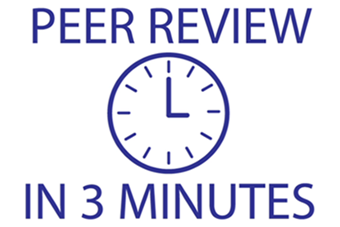4.1 Information formats
Traditionally, information has been organized in different formats, usually because of the time it takes to gather and publish the information. For example, the purpose of news reporting is to inform the public about the basic facts of an event. This information needs to be disseminated quickly, so it is published daily in print, online, on broadcast television, and radio media.
Today, publication of information in traditional formats continues as well as in constantly evolving formats on the Internet. These new information formats can include online journals, e-books, websites, blogs, infographics, visuals, or any of the social media sites in use at the time of your research. The coexistence of all of these information formats is messy and chaotic, and the process for finding relevant information is not always clear.
One way to make some sense out of the current information universe is to understand traditional information formats thoroughly. You can then understand the concepts inherent in the information formats found online. There are some direct correlations such as books and journal articles, while personal communications have evolved more significantly in format and reach over the years (e.g., the shift from letters between personal correspondents to the social media posts available to larger-scale audiences).
Primary and secondary information sources
Primary sources allow researchers to get as close as possible to original ideas, events, and empirical research as possible. Such sources may include creative works, first hand or contemporary accounts of events, and the publication of the results of empirical observations or research.
Examples of primary sources are interviews, letters, emails, texts, social media posts, photographs, speeches, newspaper or magazine articles written at the time of an event, works of literature, lab notes, field research, and published scientific research.
Secondary sources analyze, review, or summarize information in primary resources or other secondary resources. Even sources presenting facts or descriptions about events are secondary unless they are based on direct participation or observation. Secondary sources analyze the primary sources.
Examples of secondary sources are journal articles, books, literature reviews, literary criticism, meta-analyses of scientific studies, documentaries, biographies, and textbooks.
Sometimes the line between primary and secondary sources blurs. For example, although newspapers and news websites contain primary source material, they also contain secondary source material. For example, an article published on November 6, 2012 about the results of the US presidential election would be a primary source, because it was written on the day of the event. However, an article published in the same paper two weeks later analyzing how the successful candidate raised money for his campaign would be a secondary source.
Table 1. Examples of primary and secondary sources for technical writing
| Primary | Secondary |
|---|---|
| Interview with subject matter expert | Documentary on an issue or problem |
| Survey data | News article about scientific study |
| Published scientific study | Literature review on a research topic |
Popular, professional, and scholarly information
At some point in your college career, you will be asked to find peer-reviewed resources on your research topic. Your professor may explain that these appear in scholarly journals. You may wonder what makes a scholarly journal article different from an article in a magazine, like National Geographic or Sports Illustrated.
Popular magazines like People, Sports Illustrated, and Rolling Stone can be good sources for articles on recent events or pop-culture topics, while magazines like Harper’s, Scientific American, and The New Republic will offer more in-depth articles on a wider range of subjects. The audience for these publications are readers who, although not experts, are knowledgeable about the issues presented.
Professional journals, also called trade journals, address an audience of professionals in a specific discipline or field. They report news and trends in a field, but not original research. They may also provide product or service reviews, job listings, and advertisements.
Scholarly journals provide articles of interest to experts or researchers in a discipline. An editorial board of respected scholars in a discipline (peers of the authors) reviews all articles submitted to a journal. They decide if the article provides a noteworthy contribution to the field and should be published. Scholarly journals contain few or no advertisements. Scholarly journal articles will include references of works cited and may also have footnotes or endnotes, all of which rarely appear in popular or professional publications.
Peer review is a widely accepted indicator of quality scholarship in a given discipline or field. Peer-reviewed (or refereed) journals are scholarly journals that only publish articles that have passed through this review process.
You can better understand peer-review by watching the video “Peer Review in 3 Minutes.”

Table 2. Differences among magazines, professional journals, and scholarly journals
 Magazine |
 Professional journal |
 Academic journal |
|
| Audience |
|
|
|
| Bibliography |
|
|
|
| Article Characteristics (length, depth, structure) |
|
|
|
| Review policy |
|
|
|
| Author |
|
|
|
| Physical Appearance* |
|
|
|
*Note: Differences in appearances of information formats largely disappear when content is viewed online. Nearly all web content will include heavy advertising and graphics that are either relevant or irrelevant to the content at hand. You’ll have to rely on other characteristics to distinguish between formats.
Chapter Attribution Information
This chapter was derived by Annemarie Hamlin, Chris Rubio, and Michele DeSilva, Central Oregon Community College, from the following sources:
- Information Formats derived from The Information Literacy User’s Guide edited by Greg Bobish and Trudi Jacobson, CC: BY-NC-SA 3.0 US
- Information Formats: Primary and Secondary Information Sources derived from Primary, Secondary and Tertiary Sources by Virginia Tech Libraries, CC: BY-NC-SA 4.0
- Information Formats: Popular, Professional, and Scholarly Information derived from Magazines, Trade Journals, and Scholarly Journals by Virginia Tech Libraries, CC: BY-NC-SA 4.0

